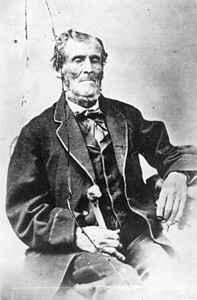 | ||
The "Anthon Transcript" (often identified with the "Caractors document") is a small piece of paper on which Joseph Smith wrote several lines of characters. According to Smith, these characters were from the golden plates (the ancient record from which Smith claims to have translated the Book of Mormon) and represent the reformed Egyptian writing that was on the plates. In 1828, this paper was delivered to Charles Anthon, a well-known classical scholar of Columbia College, Columbia University, for an expert opinion on the authenticity of the characters and the translation. Some adherents to the Book of Mormon claim that Anthon attested to the characters' authenticity in writing to Martin Harris but then ripped up his certification after hearing the story of Smith and the plates. Critics of Smith claim that Anthon believed any idea of reformed Egyptian was a hoax all along and that Harris was being deceived.
Contents
- Harriss account of meeting with Anthon
- Anthons accounts of meeting with Harris
- Caractors document
- References
Believers claim that the incident between Harris and Anthon fulfilled a biblical prophecy made by Isaiah, as Anthon is reported to have said to Harris, through Smith's telling of events, "I cannot read a sealed book."
In 1980, Mark Hofmann created and sold a forgery of the Anthon Transcript to leaders of The Church of Jesus Christ of Latter-day Saints (LDS Church), which was revealed to be fraudulent when Hofmann's crimes were investigated.
Harris's account of meeting with Anthon
In 1838, Smith related an account based on Harris's version of the meeting. Smith wrote that Anthon "stated that the translation was correct, more so than any he had before seen translated from the Egyptian. [Harris] then showed him those not yet translated, and said they were Egyptian, Chaldaic, Assyriac, and Arabic"; and that they were "true characters." According to Harris, Anthon wrote Harris a letter of authenticity declaring the fragment to contain true Egyptian characters. Anthon was also reported to have confirmed the translation of these characters as correct. When informed that an angel of God had revealed the characters to Smith, Anthon reportedly tore up the authentication stating that there was no such thing as angels and asked Harris to bring the plates to him for translation. Harris then went to Dr. Samuel L. Mitchill, who sanctioned what Anthon said.
Anthon's accounts of meeting with Harris
In 1834, Anthon stated in a letter that, "The whole story about my having pronounced the Mormonite inscription to be 'reformed Egyptian hieroglyphics' is perfectly false .... I soon came to the conclusion that it was all a trick, perhaps a hoax .... [Harris] requested an opinion from me in writing, which of course I declined giving." Anthon stated in the letter that the story of his supposed authentication was false, that Anthon had identified the writings as a hoax, and that he had told Harris that the writings were part of "a scheme to cheat the farmer [Harris] of his money".
Anthon gave a second account in 1841 that contradicted his 1834 account as to whether or not he gave Harris a written opinion about the document: "[Harris] requested me to give him my opinion in writing about the paper which he had shown to me. I did so without hesitation, partly for the man's sake, and partly to let the individual 'behind the curtain' see that his trick was discovered. The import of what I wrote was, as far as I can now recollect, simply this, that the marks in the paper appeared to be merely an imitation of various alphabetical characters, and had, in my opinion, no meaning at all connected with them." In both accounts, Anthon maintained that he told Harris that Harris was the victim of a fraud. Pomeroy Tucker, a contemporary of Harris and Smith, wrote in 1867 that all the scholars whom Harris visited "were understood to have scouted the whole pretense as too depraved for serious attention, while commiserating the applicant as the victim of fanaticism or insanity."
Caractors document
The Community of Christ purchased the handwritten slip of paper known as the Anthon Transcript from the heirs of David Whitmer. Whitmer, who once owned the document, stated that it was this slip of paper that Harris showed to Anthon. Both Mormon apologists and critics, however, claim that it is not certain that the document is the original, since Anthon had mentioned that the characters on the slip he saw were arranged in vertical columns and ended in a "rude delineation of a circle divided into various compartments, decked with various strange marks, and evidently copied after the Aztec calendar given by Humboldt," (1834) or "a rude representation of the Mexican zodiac" (1841). Recent scholarship, including handwriting analysis, suggests the "Caractors" document was written by David Whitmer's brother John Whitmer in or after 1829 and therefore would not have been available to show Anthon or others in 1828. The symbols on the document were published twice in 1844, after Smith's death, as characters that had been copied from the gold plates, one of them in the December 21 issue of The Prophet.
The document is portrayed in the 2004 film The Work and the Glory.
